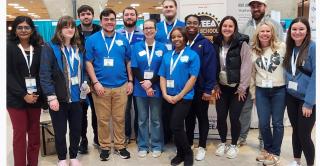
What if we could bring university information to life with a futuristic, interactive interface—something that would captivate visitors, guide students, and showcase Central’s commitment to cutting-edge technology? From that initial spark, the team set out to create the university’s first-ever Holographic Human: an immersive, AI-driven tool designed to answer questions, share campus stories, and offer a personalized, high-tech introduction to Central.
A Vision Takes Shape
The project began as a simple concept sketch on a whiteboard. For years, Central hosted open houses and campus tours that relied on printed brochures, in-person presentations, and the occasional tablet display. While effective, these methods lacked the “wow” factor that would demonstrate just how dynamic Central truly is. Determined to change that narrative, faculty members from the Computer Science, Engineering, and Marketing departments joined forces. They envisioned a life-sized holographic figure, a digital ambassador, capable of speaking to visitors, displaying multimedia content, and even fielding basic admissions queries.
Gathering the Team
A cross-disciplinary group of experts soon assembled. Software engineers set to work on the underlying AI, leveraging natural language processing and machine learning to create a system that could understand user questions and deliver informative, personable answers. Hardware specialists and design students collaborated on the physical setup: a transparent display system that would create the illusion of a three-dimensional, free-floating human figure. And from the Communication department came storytellers and multimedia artists, ready to produce compelling content and ensure that the Holographic Human had a warm, welcoming persona.
Building Selina
Selina is part-historian, part-mentor, and part-cheerleader for Central. Early prototypes of Selina were rudimentary: just a digital figure projected onto a screen in a tech lab. Under the hood, teams fed Selina thousands of data points, from department program descriptions to key performance indicators. Then they layered on top a more conversational, empathetic tone so that Selina could engage with people naturally.
A Lasting Impact
Selina representes the first AI holographic human in any higher education institution. She was a testament to Central’s dedication to leveraging technology for the benefit of students, faculty, and the broader community. In the weeks that followed, staff added more data to her memory banks—information about student organizations, athletic programs, internships, and study abroad opportunities. Soon, Selina would be ready to help not just prospective students but also new and current ones seeking guidance.
Looking to the Future
Selina’s story is far from over. Plans are underway for a “Version Three,” featuring more advanced AI, improved visuals, and integration with Central’s website so that Selina can assist online visitors just as seamlessly as she does in person. The teams are also exploring ways to bring multiple holographic humans online—perhaps a panel of digital ambassadors, each specializing in a different aspect of campus life.
In many ways, the creation of Central’s first Holographic Human was not only a triumph of technology but also a triumph of collaboration—students, faculty, and staff united by a shared passion for innovation. What began as a simple idea on a whiteboard has now become one of the university’s most iconic symbols of its future-forward spirit, ready to greet and guide the next generation of Blue Devils.


